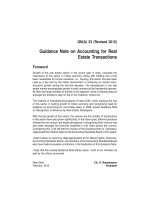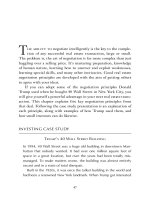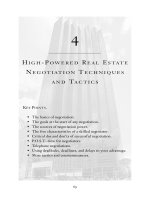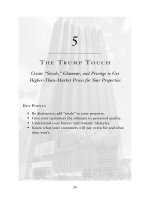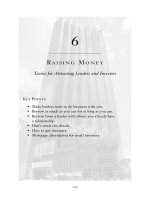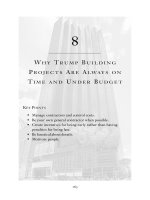TRUMP STRATEGIES FOR REAL ESTATE CHAPTER 1 potx
Bạn đang xem bản rút gọn của tài liệu. Xem và tải ngay bản đầy đủ của tài liệu tại đây (1.27 MB, 44 trang )
TRUMP
S
TRATEGIES
FOR
R
EAL
E
STATE
TRUMP
S
TRATEGIES
FOR
R
EAL
E
STATE
Billionaire Lessons for the Small Investor
GEORGE H. ROSS
with
Andrew James McLean
J
OHN
W
ILEY
& S
ONS
, I
NC
.
Copyright © 2005 by George H. Ross. All rights reserved.
Published by John Wiley & Sons, Inc., Hoboken, New Jersey.
Published simultaneously in Canada.
No part of this publication may be reproduced, stored in a retrieval system, or
transmitted in any form or by any means, electronic, mechanical, photocopying,
recording, scanning, or otherwise, except as permitted under Section 107 or 108 of the
1976 United States Copyright Act, without either the prior written permission of the
Publisher, or authorization through payment of the appropriate per-copy fee to the
Copyright Clearance Center, Inc., 222 Rosewood Drive, Danvers, MA 01923,
(978) 750-8400, fax (978) 646-8600, or on the web at www.copyright.com. Requests to
the Publisher for permission should be addressed to the Permissions Department,
John Wiley & Sons, Inc., 111 River Street, Hoboken, NJ 07030, (201) 748-6011,
fax (201) 748-6008.
Limit of Liability/Disclaimer of Warranty: While the publisher and author have used
their best efforts in preparing this book, they make no representations or warranties
with respect to the accuracy or completeness of the contents of this book and specifically
disclaim any implied warranties of merchantability or fitness for a particular purpose.
No warranty may be created or extended by sales representatives or written sales
materials. The advice and strategies contained herein may not be suitable for your
situation. The publisher is not engaged in rendering professional services, and you
should consult a professional where appropriate. Neither the publisher nor author shall
be liable for any loss of profit or any other commercial damages, including but not
limited to special, incidental, consequential, or other damages.
For general information on our other products and services please contact our Customer
Care Department within the United States at (800) 762-2974, outside the United States
at (317) 572-3993 or fax (317) 572-4002.
Wiley also publishes its books in a variety of electronic formats. Some content that
appears in print may not be available in electronic books. For more information about
Wiley products, visit our web site at www.wiley.com.
Library of Congress Cataloging-in-Publication Data:
Ross, George H., 1928–
Tr ump strategies for real estate : billionaire lessons for the small
investor / George H. Ross with Andrew James McLean.
p. cm.
Includes bibliographical references and index.
ISBN 0-471-71835-1 (cloth)
1. Real estate investment. 2. Real estate development. 3. Real estate
investment—United States—Case studies. 4. Real estate
development—United States—Case studies. 5. Trump, Donald, 1946– I.
Title: Billionaire lessons for the small investor. II. McLean, Andrew
James. III. Title.
HD1382.5.R67 2005
332.63′24—dc22
2005000053
Printed in the United States of America.
10 987654321
This book is dedicated to my wonderful wife, Billie
the solid foundation on which the happiness and success
in my life was built.
C
ONTENTS
F
OREWORD BY
D
ONALD
T
RUMP
ix
P
REFACE
xi
C
HAPTER
1
S
ELL
Y
OURSELF
L
IKE
T
RUMP
:
F
IVE
P
ERSONAL
Q
UALITIES
Y
OU
N
EED TO
S
UCCEED IN
R
EAL
E
STATE
1
C
HAPTER
2
T
HINK
B
IG
: H
OW
T
RUMP
C
HOOSES
P
ROPERTIES TO
I
NVEST
I
N
21
C
HAPTER
3
P
RINCIPLES OF
N
EGOTIATION
:
H
OW
T
RUMP
U
SES
T
HEM
45
C
HAPTER
4
H
IGH
-P
OWERED
R
EAL
E
STATE
N
EGOTIATION
T
ECHNIQUES AND
T
ACTICS
69
vii
CONTENTS
C
HAPTER
5
T
HE
T
RUMP
T
OUCH
: C
REATE
“S
IZZLE
,” G
LAMOUR
,
AND
P
RESTIGE TO
G
ET
H
IGHER
-T
HAN
-M
ARKET
P
RICES FOR
Y
OUR
P
ROPERTIES
99
C
HAPTER
6
R
AISING
M
ONEY
: T
ACTICS FOR
A
TTRACTING
L
ENDERS AND
I
NVESTORS
125
C
HAPTER
7
G
ET
H
ELP FROM THE
B
EST
R
EAL
E
STATE
S
PECIALISTS
Y
OU
C
AN
F
IND
153
C
HAPTER
8
W
HY
T
RUMP
B
UILDING
P
ROJECTS
A
RE
A
LWAYS ON
T
IME AND
U
NDER
B
UDGET
165
C
HAPTER
9
T
RUMP
M
ARKETING
S
TRATEGIES
:
S
ELLING THE
“S
IZZLE
” S
ELLS THE
P
RODUCT
179
C
HAPTER
10
H
OW TO
M
ANAGE
P
ROPERTY
L
IKE
T
RUMP
:
T
REAT
I
TASA
C
USTOMER
S
ERVICE
B
USINESS
193
C
HAPTER
11
H
OLDING
S
TRATEGIES AND
E
XIT
S
TRATEGIES
207
I
NDEX
223
viii
F
OREWORD
by
Donald Trump
(In the author’s copy of The Art of the Deal)
T
o George—
There is no one like you. Only you and I know how important a
role you played in my success—Thanks for everything!
Best wishes,
Donald Trump
ix
xi
P
REFACE
I
’
VE SPENT
50
YEARS
as a lawyer, business advisor, and deal nego-
tiator for real estate tycoons at the top of the world’s toughest real
estate market—New York City. I’ve represented or negotiated with
great real estate minds like Harry Helmsley, Sam LeFrak, Bill Zeck-
endorf, and Donald Trump. It’s been my good fortune to spend many
of the best years of my career as Donald’s right-hand man.
These days most people know me best from the TV show, The
Apprentice, where Carolyn Kepcher and I help Donald make tough
decisions about whom to fire and whom to keep. The show has been
fun, but most of my work for Donald over the past 25 years has been
in the world of real estate. I have been an advisor, negotiator, and
lawyer on many of his biggest and most successful real estate invest-
ments, including the acquisition and renovation of the GM building,
Tr ump Tower on 5th Avenue, the Grand Hyatt Hotel, and my per-
sonal favorite, 40 Wall Street.
Throughout my career, I have had the opportunity to acquire a
great deal of knowledge and experience in real estate investing,
which I hope to pass on to you in this book. For example, during a
10-year period from 1956 to 1966 when Sol Goldman and Alex
DiLorenzo Jr. became two of the biggest property owners in New
York, I personally bought 702 individual properties on their behalf. I
have been intimately involved in many of New York City’s most
spectacular projects, such as the Chrysler Building and the St. Regis
PREFACE
xii
Hotel, which I helped one of my clients buy. I’ve also had the oppor-
tunity to watch Donald Trump in action as he made some of the
greatest real estate investments in history.
This book explains the strategies Donald Trump used to make
his real estate fortune, and how small investors can apply them to in-
vestments of any size, right down to a one-family rental property. I
describe how Trump implements some of his signature strategies
such as creating luxury, perceived value, exclusivity, and attention to
detail, which all come together to maximize the value of his invest-
ments. (This is why his properties earn far more money, square foot
for square foot, than his competitors’.)
A number of the chapters focus on a particular real estate invest-
ment that I was directly involved in negotiating or advising Trump
on. Using this example, I draw out the lessons and explain how the
same strategies that Trump used to make huge profits on his deals
can work for you—the small investor. Although Trump does things
on a grand scale and his target market is usually an elite, luxury cus-
tomer, Trump’s basic real estate strategies will be of interest to:
•Anyone who is interested in owning or developing real estate
•Anyone unsure of how to negotiate a real estate transaction
•
Anyone who isinrealestateonasmallscalebutwouldliketo
do more
•
Anyone interested in learning how Donald Trump does
hismagic
This is the first book on Trump’s strategies for the real estate
investor. Although it has a lot of nuts-and-bolts guidance and in-
vesting principles, the book alone will not make you a great in-
vestor. As I tell the students who take my negotiation course at New
York University, “There’s no way in 15 hours that I can make you
P
REFACE
xiii
an excellent negotiator. It is impossible! All I want to do is open
your mind to the possibilities and the power of negotiating, and
some basic techniques. Then, when you run into a specific situation
you can go back to your notes, and say, how did George handle this?
Or, what did he suggest?” You already have some ideas about real
estate, but I’ve learned many things in my 25 years working with
Tr u mp a nd 50 years in the real estate business, that I’d like to pass
along to you. If I am successful, this book will help you negotiate
far better deals, arrange better financing, make better investments,
and earn significantly more money in real estate.
I recall the day I first met Donald Trump in 1974. He entered my
office at the law firm of Dreyer and Traub beaming with enthusiasm
about a project he wanted to do with the old Commodore Hotel on
42d Street in New York City. He was just 27 years old at the time, and
I was a senior partner known for completing complex deals, but I
agreed to see him out of courtesy because I represented his father,
Fred Trump. Fred had spoken enthusiastically about Donald’s promise
as a future star in the real estate world.
Donald laid out his incredibly complex plan for buying the huge,
dumpy, rundown hotel next to Grand Central Station and turning it
into a first-class, state-of-the-art business hotel. I told him it was a
brilliant idea, but there was no way it would ever work, given the num-
ber of powerful people and governmental agencies he would have to
convince to grant him major concessions. Nevertheless, if he was will-
ing to pay the legal fees, I was willing to help him take a shot at it. We
spent the next two years negotiating with railroad executives, city and
state officials, lenders, and Hyatt executives making the deal happen.
During those tumultuous two years, Donald and I developed a great
working relationship and mutual respect. When he miraculously
pulled off the deal, I was so sure he would be a huge success in real es-
tate that I became his closest advisor and lawyer.
PREFACE
xiv
H
OW
M
Y
C
AREER
S
TARTED
When I was young, growing up in Brooklyn, New York, I planned to
go to MIT to be an engineer, but my father died suddenly when I was
16 and that plan died with him. At 17 I enlisted in the U.S. Army be-
cause they offered to send me to college. When I went on active duty,
I was trained as a cryptanalyst (a code breaker) and spent most of my
short army career in Washington, DC. The analytical skills, pa-
tience, and tenacity I learned as a code breaker helped me when I was
faced with seemingly unresolvable real estate problems.
With the help of the GI Bill, I obtained my BA degree at Brook-
lyn College and entered Brooklyn Law School. Working three jobs
concurrently and with the support of my working wife, I graduated
and was admitted to the New York Bar in 1953.
While looking for a job, I saw an ad in the Law Journal for a law
clerk. As luck would have it, the person who answered the phone was
Bill, a friend from law school. He was working for Dreyer and Traub, a
well-known real estate law firm. Bill said, “You don’t want this job.
Yo u’ll be nothing but a messenger and it only pays $25 a week.” But I
took it anyway! That was the inauspicious beginning of my legal career.
Although Dreyer and Traub was a law firm dealing primarily with
real estate matters, they handled litigation as a courtesy for their
clients, and Bill and I worked in the litigation department. Several
months later there was an opening upstairs in the real estate acquisi-
tion and leasing practice, the place where real money was made.
It was
an excellent opportunity for advancement and Bill was slotted for
the job. I was to take his spot in litigation. But before he could start,
he was drafted into the army and recommended me for the real es-
tate position. Once upstairs, I had the good fortune to apprentice to
Murray Felton, a very tough taskmaster. He was so demanding that
if I put a comma in the wrong place, I would hear about it for days.
But Felton was a superb technician and highly regarded in the
P
REFACE
xv
world of real estate attorneys. I knew that working with him was a
great opportunity to learn the intricacies of real estate law from a
perfectionist. So I soaked up every bit of helpful information I
could from him. I became adept at drafting leases, real estate docu-
ments, and participating in all types of transactions. My prior liti-
gation experience added to the perception that I was a competent,
though young, real estate attorney.
L
EARNING THE
R
EAL
E
STATE
B
USINESS
In 1955, one of my clients asked me to draft a commercial lease for
him even though he was to be the tenant. Usually, the landlord’s at-
torney drafts the lease, but in this case the landlord told my client to
have his lawyer prepare the lease. So I drew up the lease and inserted
a provision stating that the tenant didn’t have to pay any rent before
the landlord made a certain elevator operational. My client moved in
and, as it turned out, the elevator inspector for New York City re-
fused to accept the elevator repairs the landlord made, insisting that
only a brand new elevator would get his approval. The elevator stayed
out of operation for a very long time, but throughout that period my
client was still able to carry out his normal business operations.
Theowners, Sol Goldman and Alex DiLorenzo Jr. had a “tenant
in possession” utilizing the premises for its normal business opera-
tions, but because of that clause in the lease, the tenant was not paying
them any rent! Although the landlords were very unhappy they were
helpless.
In the mid-1950s, Goldman and DiLorenzo, who were both
mul
timillionaires, had decided to invest in real estate on a huge scale.
I had decided to leave Dreyer and Traub because I had been told that
there was no possibility for me to become a partner in the firm. I
happened to mention my impending departure to Sol Goldman and
PREFACE
xvi
he called me a few days later and said, “George, Alex and I would like
you to be our counsel.” I said, “Why me?” He said, “Well, we al-
ready paid $90,000 in the form of lost rent just for the privilege of
knowing you! We’ll make it worth your while if you say yes.” I ac-
cepted their offer.
E
VERY
P
ROBLEM
H
AS A
P
RICE
T
AG
Very quickly I learned something that every real estate investor
should understand: There is a huge difference between the legal as-
pects of real estate and the business of investing in real estate. I had
to restructure my whole way of thinking. Whenever I discovered a
legal problem with a real estate deal, Goldman would say, “Is it seri-
ous enough to blow the deal?” If I said, “No.” Then he would say,
“How much can I get off the price for the problem?” Most lawyers
simply advise their clients not to do a deal if they find legal problems;
lawyers cannot or will not make business recommendations for their
clients. Goldman forced me to think like a businessman, not just a
lawyer, and realize that almost every problem has a price tag. He
forced me to look at legal problems strictly as a way of improving the
deal. He’d say, “What can I get if I overlook this problem?” To find
that answer, I had to dig into the problem.
For example, Goldman and DiLorenzo contracted to buy Har-
borside Terminal in Jersey City, New Jersey, from the railroad that
owned it. The property consisted of a huge cold storage warehouse of
almost two million square feet abutting the Hudson River, right
across the river from downtown Manhattan. The purchase price
seemed reasonable even though it was to be an all-cash deal. How-
ever, the title report contained an exception for possible claims of the
State of New Jersey to a strip of land that the warehouse straddled. It
became clear to me why the railroad was having difficulty finding a
P
REFACE
xvii
buyer. No lawyer would let a client buy the property with such a de-
fect and certainly no bank would place a mortgage on it. The problem
related to land under water that was filled in sometime in the 1800s.
A law was passed stipulating that if the land under water was filled in
by the adjoining landowner before 1849, the landowner had good
title to it. If it was filled in after 1849, the State of New Jersey owned
it. I couldn’t prove when it was filled in and who filled it nor could
the State of New Jersey.
I told Sol we should get a price reduction and also convince the
railroad to take back a long-term purchase money mortgage at a low
interest rate since no lender would make any loan because of the title
defect. The railroad agreed to reduce the purchase price by $400,000
and to take a sizable mortgage, so we closed the deal. Several years
went by but the title impediment still stuck in my craw. I was certain
that the State of New Jersey must have encountered the same prob-
lem in the past since much of the land abutting the Hudson River was
filled-in land. I contacted the State and learned that they were aware
of the problem and rather than sit with a dubious claim they had
passed a statute giving the State the right to give up its claim in ex-
change for the value of their interest in the disputed land. Following
the procedure outlined in the statute, we paid a minimal amount and
received a quitclaim deed to the land in dispute from the State of
New Jersey. As a result, the property appreciated in value so much
that a bank made a first mortgage loan in an amount exceeding the
total purchase price paid by Goldman and DiLorenzo.
From 1956 to 1966 Goldman and DiLorenzo were New Yorkreal
estate. When I arrived at Goldman and DiLorenzo in 1956, they
owned18properties; when I left in 1966, they owned 720. I negoti-
ated and handled almost all of these purchasesby myselfwith very lit-
tle supervision from them. We were buying Manhattan ground leases
by thedozen, warehouses in New York harbor, and multimillion-
dol
lar office buildings. We were dealing in big num
bers, and much of
PREFACE
xviii
it was done with cash. Many times I walked into a closing on a prop-
erty with a certified check for millions of dollars inmywallet.Iwas
also given a standing million dollar deposit by Goldman and
DiLorenzo with which to negotiate. Goldman and DiLorenzo
would tell me what typeofdealtheywantedandmyjobwastomake
it happen. They were not anxious buyers, so if I didn’t think the
deal met their terms, I would kill it and goontothenextone.
That’s what enabled them to acquire so much real estate so quickly.
During that 10-year period, I bought the Chrysler Building, the St.
RegisHotel, the land under the Plaza Hotel, Harborside Terminal
in Jersey City, and numerous ground leases on their behalf. (A
ground lease isalong-term lease for land on which a building sits,
andgives the tenant all the rights and obligations of operation and
ownership except title to the land.)
Goldman and DiLorenzo’s appetite for real estate was voracious.
They had excellent financing connections which enabled me to close
transactions quickly. As their lone lawyer and business representa-
tive, I had almost unlimited authority to negotiate but not to in-
crease the purchase price. I negotiated with Harry Helmsley, Bill
Zeckendorf, and Morris Karp to name a few. These were all the big
names in New York real estate at that particular time—pretty heady
stuff for a 30-year-old lawyer.
For the first few years I worked for Goldman and DiLorenzo,
I was in way over my head. At Dreyer and Traub, I was handling
closings on single-family homes in New Jersey. I had never done a
contract and closing on any office building of any size. Now I was
thrust into an arena involving the purchase and operation of huge
office buildings. I really had no prior training or experience. Yet ev-
eryone thought, because I was so young and represented these mil-
lionaires in huge transactions, I must be brilliant so they treated me
as an equal. I knew how green I was, but I wasn’t going to dispute
their assessment of me! I learned as fast as I could from everyone I
P
REFACE
xix
came in contact with, including all the people on the other side—the
lawyers and other professionals and the real estate moguls them-
selves. I concentrated on what they did, how they did it, how they
acted and reacted in certain situations, and anything else that would
fill the void of my ineptitude. I was like a sponge absorbing every bit
of information I could. Before long my crash course in real estate
paid off and I began to give my clients well-reasoned opinions as to
which deals were good and which were not and what price to pay.
This gave me a unique combination of talents. Most lawyers don’t
know the business of real estate, and therefore, they are not
equipped to make business decisions. They are ready to render ad-
vice on any legal issue, but leave the business decisions to their
client.
R
ADIO
D
AYS
Any good lawyer will make lots of money while practicing law, but
since lawyering is a service business, the income stops when you step
down. I recognized the need to invest in some enterprise that would
be of value in my later years. In 1966, my brother-in-law, Martin
Beck, was leaving the Katz Agency, a big name in the business of sell-
ing radio time. He suggested that we look for investment opportuni-
t
ies together. He thought radio broadcasting on Long Island would be
profitable. I told him, “I don’t know anything about the radio busi-
ness.” He said, “I know all about radio but I don’t know how to raise
the capital necessary for a venture.” I told him, “You find and run the
stations and I’ll find the money to make it happen.” In 1966, we
formed Beck-Ross Communications Corporation and bought our first
radio station in Long Island, WGLI, for approximately $450,000.
Marty knew how to make money in radio broadcasting. Using the
profits from WGLI and by expanding our financial contacts, we
PREFACE
xx
em
barked on a plan of expansion. FM broadcasting was in its infancy
but the superiority of the sound made it an attractive prospect. We
purchased several other stations—both AM and FM—increased
their market share, and then sold them at huge profits. In 1986,
Marty and I bought out all of our investors for 25 times their origi-
nal investment. In 1987, we were faced with a decision that many in-
vestors confront at some time, to expand the business or sell out to
someone who would. We chose to take a substantial profit and leave
the expansion to the buyer.
But the radio business was only a sideline to my law career. In
1966, after 10 years with Goldman and DiLorenzo, my reputation
had grown to the point where I could have received a partnership
with any quality law firm with a real estate department. I opted to re-
turn as a partner to my old firm, Dreyer and Traub, where I was
being accepted as a senior partner. I realized that since only two
young attorneys had become new partners in the past 10 years and
the old partners were reaching retirement, it would be my firm
within a few years. That’s exactly what happened. By the early
1970s, I became one of four senior partners running one of the best
real estate law firms in New York with as many as 120 lawyers. I led
that firm for more than 20 years.
Eventually, I got tired of dealing with partnership politics, gave
up the active practice of law, got a severance package, and joined the
Edward S. Gordon Company where my role for the next 10 years was
to supply real estate expertise to major clients like United Technolo-
gies, IBM, the New York Times, and AT&T.
H
OW
I C
AME TO
W
ORK FOR
D
ONALD
T
RUMP
Although I left the active practice of law in 1987, I remained friendly
with Donald Trump, and though I had worked with him on many of
P
REFACE
xxi
his most successful projects, I was no longer his lawyer. When the
New York City real estate market tanked in 1990, Trump hit the
rocks. It was not due to a lack of business acumen; rather, his phe-
nomenal success had created an air of invincibility. Because he had
been so incredibly successful, he began to think that any business he
touched would turn to gold.
The banks would throw money at him. If he asked to borrow $60
million for a building, they gave him $80 million. When the bottom
fell out of the New York City real estate market, he was vastly
overextended and was over $990 million in debt. He owed so much
money that the lenders knew if they forced him into bankruptcy it
would have a disastrous effect on the real estate market. They had
many bad loans that they didn’t want to write off. So they came up
with a plan that would enable him to work his way back by agreeing
to accept a substantial reduction if the loans were repaid by a certain
future date.
Even though I was no longer a member of a law firm, I
wanted to help. I told Donald that if he ever needed legal advice or
counsel while he was in trouble, I would be happy to do it for him
without charge. He was impressed and asked me why I would do
that. I said, “Donald, I think a lawyer has a responsibility to repre-
sent a client when he’s down, not only when he’s on top. I’m here if
you need me.” Trump never accepted my offer because it’s not his
style to get something for nothing. But I’m sure he appreciated the
gesture. My philosophy has since paid off in spades—with Donald
Tr u mp, loya lty goes a long way.
In the mid-1990s, Donald had two deals going, the new Nike
Building adjoining Trump Tower and 40 Wall Street. Both were
plagued with problems because of the lawyers involved, and very lit-
tle was getting accomplished. Donald knows when to use delay tac-
tics, but he also hates deals that drag on and on. So he hired me to
eliminate the roadblocks and get those deals done. While I was
PREFACE
xxii
working on them, I told Donald that I was bored with my life at
Gordon and was planning to retire. He asked me to join the Trump
Organization on a full-time basis. He said, “I’ve got a lot of great
things going and you’ll have fun.” We quickly agreed on terms (I
only work four days a week) and 10 years later, I’m still an important
part of the Tr u mp team.
My title is Senior Executive Vice President and Senior Counsel for
the Trump Organization and my primary function is to give Donald
Tr ump business and legal advice. I offer my opinion as to the feasibil-
ity of his proposed projects, which he is free to accept or reject. He
likes to bounce things off me before reaching his own decision. He
knows that I will call it like I see it and give him an unbiased opinion.
I’m currently responsible for developing many foreign investments for
Donald and supervising the leasing and operation of 40 Wall Street
and Trump Tower.
Additionally, I teach a course at New York University on negoti-
ation. Negotiation is a subject that I have made a study of throughout
my career, because it is such a critical part of real estate success. I
could easily fill a book on this subject. For a discussion of some of
the principles and techniques, used by Trump, that I think are most
valuable, see Chapters 3 and 4.
Tr ump has been a great man to work for. In 10 years, he has
never once asked me where I’m going or what I’m doing. That’s the
kind of trust we have. When he gave me responsibility for 40 Wall
Street, I took the building from where it was—a one-million-square-
foot nearly vacant structure he purchased for $1 million—to where
it is now—a thriving office building worth in excess of $350 million.
After 40 Wall Street had been rented and had become extremely
profitable for Trump, I said to him, “I think I’m entitled to a bonus
for 40 Wall Street.” Trump’s reply was, “How much do you think
you’re entitled to?” I gave him a figure. He said, “You’ve got it.” It’s
this kind of recognition that makes it a pleasure to work for him.
P
REFACE
xxiii
Fred Trump once said to Donald when he needed a lawyer, “You
would be hard-pressed to find a wiser, more loyal, or a better advisor
and lawyer than George Ross.” I’m delighted Donald took that ad-
vice and gave me the opportunity to work with a true real estate
genius. Now I hope to pass on to you some of the powerful investing
strategies I’ve learned from some of the greatest real estate minds in
the business.
A
CKNOWLEDGMENTS
My gratitude to Donald J. Trump for becoming such an important
part of my life as a friend and for giving me the unique opportunity
throughout my career to help turn his visions of spectacular projects
into realities.

